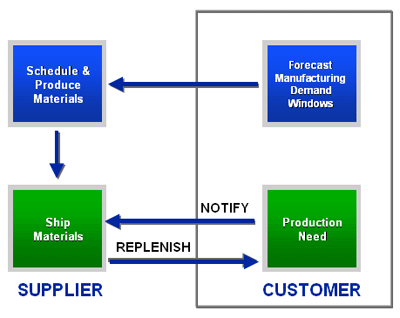Production Demand Replenishment
Production Demand Replenishment
Executive Overview
The Production Demand Replenishment (PDR) technique was one of the many innovative business practices initiated by the Japanese to gain competitive advantage in the world marketplace. PDR’s innovations to JIT methodology encompasses and goes beyond conventional kanban to enable strategic improvements to supply chain management for manufacturing companies.
Simply put, PDR eliminates the costly and ineffective planning based customer material acquisition system with material replenishment based at the source of demand. A process that requires the customer to drive material requirements based on actual production need, and not by relying on inventory records. PDR is:
- A competitive requirement
- A supply base management strategy
- An organizational capability
PDR is a fundamental change to the procurement cycle with a major emphasis on purchasing, supplier, stocking and receiving processes. PDR is not a software solution and, in most cases does not require major software changes to current business systems. In addition, PDR does not require Electronic Data Interchange (EDI) capability for implementation.
The PDR process which begins with the customer providing suppliers a forecast of expected material requirements. Forecast submission provide the suppliers with information required to plan and access customer requirement changes and make necessary changes to scheduling, material ordering, and capacity processes. Customer requirement for material is triggered by a separate visual process based on actual production needs. The customer notification signal notifies supplier to ship material based on mutually agreed requirements. Material is received at the customer site and delivered directly to the point of use.

IMPACTS
- PDR requires a systematic integration of new values, structures and disciplines into the material replenishment cycle which will have impacts across a multitude of organizations for both the customer and the supplier.
Customer
- Bill Of Material Stability
- Manufacturing Execution
- Strategic Supplier Relationships
- Level Production Schedule (preferred)
- Cell Manufacturing (preferred)
- Supplier Forecast Plant and Cell Layout
- Internal Pull System
- Determination of Storage Location
- Returnable Containers
- Transportation Logistics
- Engineering Change Management
- System Changes
Supplier
- Supplier Material Quality
- Level Production Schedule (preferred)
- Supplier Forecast
- Supplier Requirements
- Returnable Containers
- Transportation Logistics
- Engineering Change Management
- System Changes
BENEFITS
- When fully implemented, PDR will eliminate material shortages, and overhead associated with traditional material acquisition management. Other benefits within customer’s and supplier’s functions include
- Drastically improved Inventory Turns, Days Inventories Outstanding and associated working capital
- Reduced cycle counting (customer)
- Reduced material handling and storage space (customer)
- Reduced exception handling via action messages (customer/supplier)
- Reduced data entry costs (customer/supplier)
- Reduced clerical personnel (customer/supplier)
- Fewer clerical errors (customer/supplier)
- Increased cash from inventory reduction (customer)
- As a result of the process requiring accurate and timely replenishment signals and receipts, PDR delivers additional benefits in improved customer supplier relations. Among the key benefits for Manufacturing and other functions are
- Improved flexibility and responsiveness to marketplace
- Improved quality
- Improved supplier on time delivery performance
- For companies looking to engage scarce resources to real quantum leap business improvement, PDR provides a strategic process improvement and the benefits of a proven, reengineered solution. PDR is a validated solution, it requires the cross functional involvement of marketing, manufacturing, materials, quality and accounting. The vast majority of perceived issues are already resolved. This success will provide impetus to your organization’s change efforts. In addition, PDR implementation efforts typically become a catalyst for initiating additional change in the manufacturing and administrative process.

